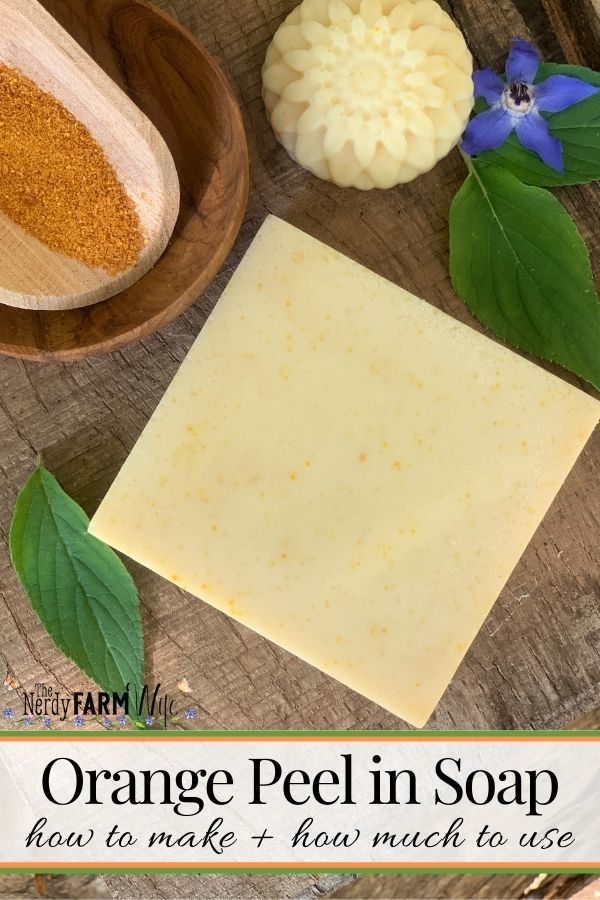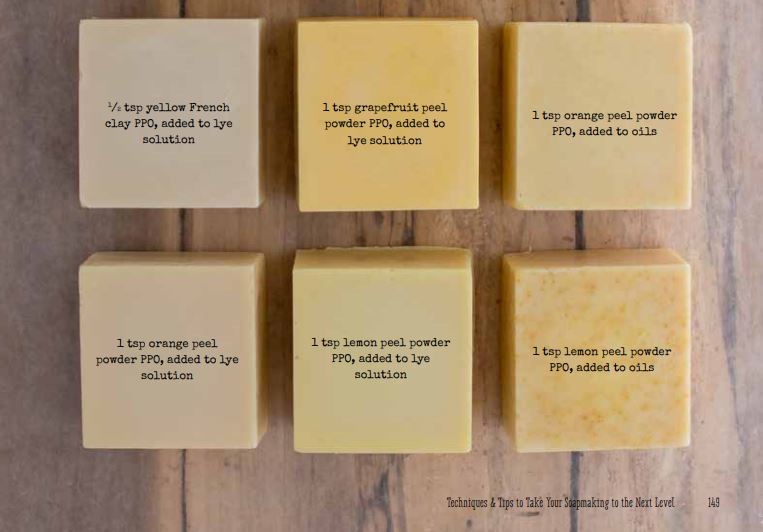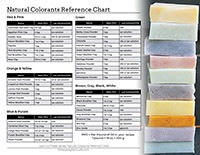How to Make & Use Orange Peel Powder for Soapmaking
Learn how to make your own orange peel powder and how to use it in cold process soap recipes.

Do you or your family enjoy snacking on fresh oranges?
If so, save some of those peels for your soapmaking projects!
Orange peel powder adds:
- soft natural color
- label appeal
- loads of flavonoids (antioxidants)
Depending on the texture of the powder used (coarse or fine), it can act as an exfoliant as well.
Tip: Be sure to use organic oranges, since pesticides can be concentrated in the peeling.
When should you add orange peel powder to soap?
You have a lot of options, so I suggest experimenting with each way, to see which one you like best.
I often like to add orange peel powder to the hot lye solution since I feel it gives the finished soap a smoother look.
However, you could also infuse it into your oils, or add to the warmed oils before adding the lye solution.
Still other soapmakers like to stir in the powder at trace. (Doing this will usually lead to the most speckled and exfoliating effect.)

How much should you use?
For orange peel, lemon peel, and grapefruit peel powder, I like to start with around 1 teaspoon PPO.
PPO = Per Pound of Oil in a recipe. (1 pound = 16 ounces = 454 grams)
So if your recipe has a total of 16 ounces of oil, use 1 teaspoon orange peel powder. If it has 32 ounces of oil, use 2 teaspoons of powder. If it has 24 ounces of oil, use 1 1/2 teaspoons powder.
My recipes usually have 28 ounces of oil, so I start with 1 3/4 teaspoon of powder in a batch.
(The soaps shown above are from the natural colorant photo gallery in my print book, Simple & Natural Soapmaking.)
Will orange peels spoil in soap?
As long as you use finely powdered peelings, there’s no need to worry about it spoiling in soap or affecting shelf life.
Large chunks or pieces of any type of food can spoil and/or mold inside of soap though, so stick with a fine powder, or just the zest.
Also be cautious about sprinkling orange zest or powder on top of soap. Food items added to the top of soaps can more easily collect mold in humid areas such as bathrooms.
To be on the safe side, made sure the powder is thoroughly mixed into the soap batter.
How to Make Orange Peel Powder for Soap
Making orange peel powder is very easy!
Before enjoying an orange for a snack, use a box grater or knife to grate or slice off the colored part of the peeling, leaving behind as much of the white pithy part as possible.
If you live in a dry climate, you can air dry the pieces in a single layer on parchment paper.
For normal to more humid climates, I recommend putting the peel in a single layer on a parchment lined baking pan and using an oven set to lowest heat (170 degrees F), checking and stirring every 5 minutes until dried and brittle.
If you have a dehydrator, line a tray with parchment and dehydrate at 130 degrees for several hours, checking and stirring every hour or two.
Run the completely dried and cooled pieces through a coffee grinder to make a powder.
Next, sift through a fine mesh sieve to get a softer and finer powder. Finer powders will leave little speckling in soap, while coarse powders will speckle more.
Store the powder in a small jar and label. Shelf life should be at least one year, or as long as the powder has a citrus scent and nice color.



Great idea! I have two lemon trees in my backyard and will try this.
Hi Julia, That sounds great! And how wonderful to have two lemon trees in your backyard to enjoy! ?
Loved your article Jan. I was looking for a way to naturally color my sweet orange scented soap without mica. Definitely gonna try your orange peel method.
Hi Brittany, So happy to hear you enjoyed the article & hope it works well for you! ?
Hello Jan,
Can I use this for melt and pour soaps, too? When should I add the powdered peels?
Thank you,
Martha
Hi Martha! Yes, this would work great for melt and pour too!
Add about 1/4 teaspoon per 4 ounces of soap if you’re using a white base. (Or 1/8 tsp per 4 ounces of soap for clear base.)
Mix it with about 2 to 3 times as much rubbing alcohol to dilute it, then stir it into the melted soap base.
If you have a way to keep track of temperature, it helps to pour the soap at 125 to 135 degrees – when it’s that cool, it will keep the orange/lemon peel powder from all sinking to the bottom.
Jan, thanks for this article! I have purchased some homemade soap that I love. I’ve never been able to duplicate the recipe. It has a little grit in it. I was wondering what the grit is, but after reading this article I think it might be orange peel. I’m going to try this in my next batch. Thank you!
Hi Elizabeth, So happy that the article was helpful! :)
Jan,
Can this type of orange dry peel be used to sprinkle on a whole baked chicken ?
Can it be used for cooking, baking purposes, to flavor teas ?
Hi Boo, Yes! This is the same way you’d dry orange and lemon to use for food/culinary purposes too. :)
Does the adding of dried fruit peel with lye cause the peel to degrade like fruit essential oils and should only be added at trace or used with other types of soap process than cold process soap making?
Hi Jackie! In my experience, the dried fruit peel holds up fine with lye exposure. It doesn’t give the soap any scent, which is where citrus essential oils run into trouble (their scent evaporates so quickly!) :)